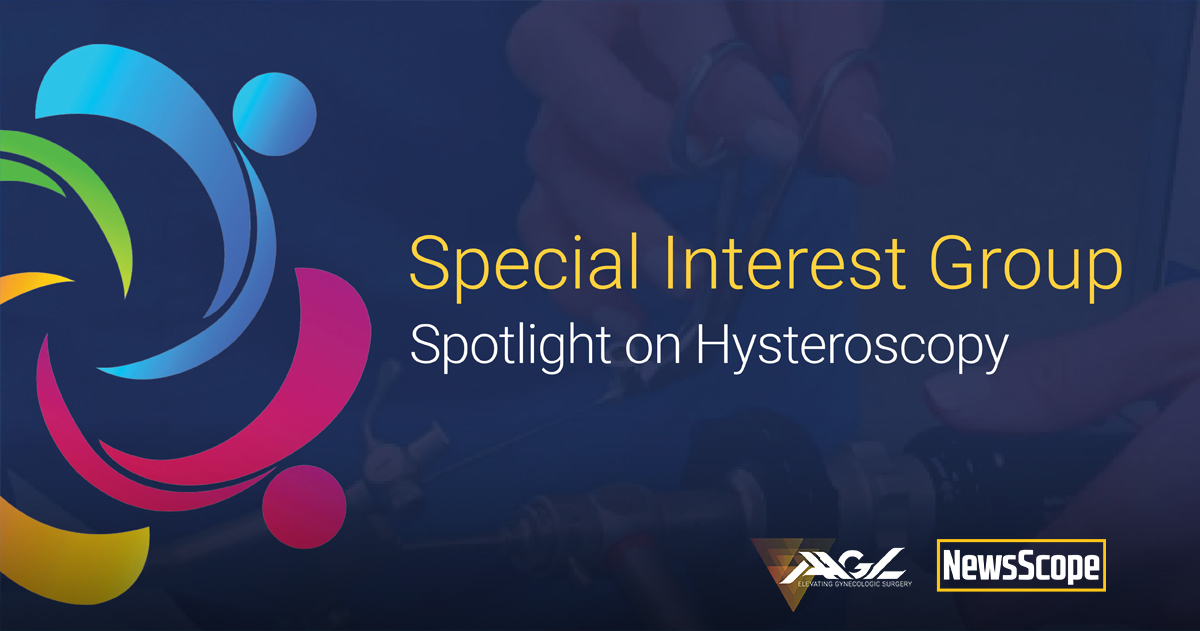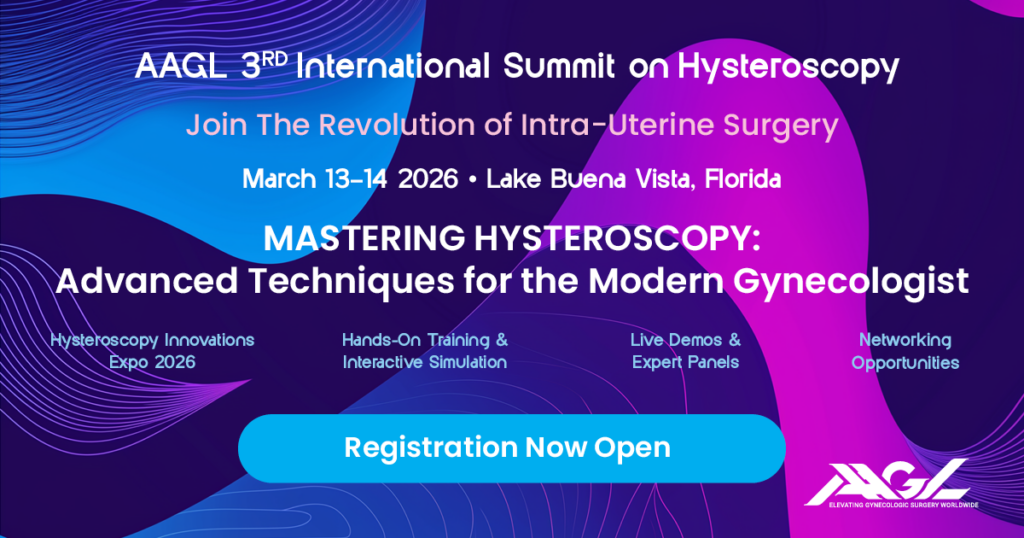Doctors Most Challenging Case: Osseous Metaplasia of the Endometrium – An Enigmatic Pathologic Diagnosis

In the last issue of NewsScope, we launched a new series called “Doctors Most Challenging Case.” We’ve asked the chairs from our six Special Interest Groups (SIG) for articles, videos and information from their SIG to be featured in the next issues of NewsScope. The purpose is to provide information and updates in each area and to share their most difficult or toughest case, how they managed it and what they learned from the process. The SIG spotlight last month was on Robotics and this month, articles submitted were from AAGL’s Hysteroscopy SIG. The most difficult case has to deal with osseous metaplasia, a rare condition in which there is a transformation of normal endometrial tissue into bone (Fig. 1), outlined in in the article below.
Thanks to all the AAGL SIG chairs, vice-chairs and members – for the informative and timely articles and for supporting this exciting series! If you would like to join an AAGL SIG in Urogynecology, Robotics, Oncology, Endometriosis, Pelvic Pain or Hysteroscopy, contact Seth Spirrison via email to sspirrison@aagl.org. Your AAGL membership must be current and in good standing.
Osseous metaplasia is a rare condition in which there is a transformation of normal endometrial tissue into bone (Fig. 1). It is an uncommon clinical entity with an incidence of 0.3/1,000 woman with most cases occurring after voluntary or spontaneous pregnancy loss (1). It frequently presents with irregular vaginal bleeding, dysmenorrhea, chronic pelvic pain and infertility (2). It is suspected by the presence of hyperechogenic structures with acoustic shadow on ultrasound. Hysteroscopy, with removal of the bony structures, is considered the most effective diagnostic and therapeutic modality (3).
We present a case of a 36-year-old G2P1011 patient who presented to our hospital 6 months after elective termination of a 20 week intrauterine pregnancy secondary to multiple fetal malformations. The patient underwent induction of labor with misoprostol and delivered an intact fetus. The procedure was complicated by postpartum endometritis for which she underwent dilation and curettage and was treated with antibiotics. She complained of persistent pelvic pain and irregular bleeding not responding to medical treatment since the day after the procedure. Ultrasound revealed the presence of a linear echogenic structure suggestive of a possible foreign body (Figure 2). Diagnostic hysteroscopy was performed and revealed the presence of an inflamed hyper-vascular and edematous endometrium (Figure 3). A uterine perforation was noted at the level of the lower uterine segment (Figure 4). Also, the presence of several small bony structures in the endometrial cavity were noted that were easily removed. The patient had an uneventful post-procedure course and the symptoms entirely resolved.
There are two main theories aiming to explain the presence of bony fragments in the endometrial cavity. One, proposed by Thaler, relates this entity to retention of osseous fetal parts after abortion of pregnancies with a gestational age of 12 weeks or above. The second and most accepted theory, proposes a true endometrial osseous metaplasia, in which there is an osseous transformation of the endometrial stromal cells as a consequence of an irritative, toxic or hormonal stimuli (4). It is possible that both theories are correct, with cases of true metaplasia and cases in which, due to trauma during the procedure, retained small fragments of bone remain inside the endometrial cavity. Most patients with endometrial osseous metaplasia are asymptomatic. However, additional associated clinical symptoms include secondary infertility, vaginal bleeding, dysmenorrhea, chronic pelvic pain and spontaneous expulsion of bony fragments with menstruation.
The initial diagnosis and subsequent follow-up are usually performed with ultrasound. The bony structures can be visualized as a hyperechogenic area with acoustic shadow inside the uterine cavity. Hysteroscopy is the gold standard therapeutic modality, which allows the visualization of bony spicules, or less frequently, well-formed fetal bones (Fig. 1). The use of the hysteroscopy allows for complete removal of this tissue without damaging the endometrium.
In cases in which there is associated secondary infertility, the complete removal of the bony structures is associated with restoration of fertility. In a recent systematic review including 64 women, Bozdag found that complete removal of the bony structures either by hysteroscopy or dilation and curettage is associated with a rate of spontaneous pregnancy of 52% within the first year (5).
Osseous metaplasia is a rare clinical entity that must always be considered when in presence of patients with a history of pregnancy loss and a finding of hyperechogenic structures within the endometrial cavity.
References:
- Pereira MC, Vaz MM, Miranda SP, Araujo SR, Menezes DB, das Chagas Medeiros F. Uterine cavity calcifications: a report of 7 cases and a systematic literature review. J Minim Invasive Gynecol. 2014;21(3):346-52.
- Chervenak FA, Amin HK, Neuwirth RS. Symptomatic intrauterine retention of fetal bones. Obstet Gynecol. 1982;59(6 Suppl):58S-61S.
- Coccia ME, Becattini C, Bracco GL, Scarselli G. Ultrasound-guided hysteroscopic management of endometrial osseous metaplasia. Ultrasound in Obstetrics & Gynecology. 1996;8(2):134-6.
- Umashankar T, Patted S, Handigund R. Endometrial osseous metaplasia: Clinicopathological study of a case and literature review. J Hum Reprod Sci. 2010;3(2):102-4.
- Bozdag G, Mumusoglu S, Dogan S, Esinler I, Gunalp S. Osseous Metaplasia and Subsequent Spontaneous Pregnancy Chance: A Case Report and Review of the Literature. Gynecologic and Obstetric Investigation. 2015;80(4):217-22.
Figure 1. Appreciate the bony structure present in the endometrial cavity.

Figure 2. Ultrasound image revealing the presence of a linear echogenic structure with acoustic shadow.

Figure 3. Hysteroscopic view of the endometrial cavity. Note the presence of edematous and inflamed endometrium.

Figure 4. Uterine perforation. Note the clear, well-delineated perforation in the uterine wall.







